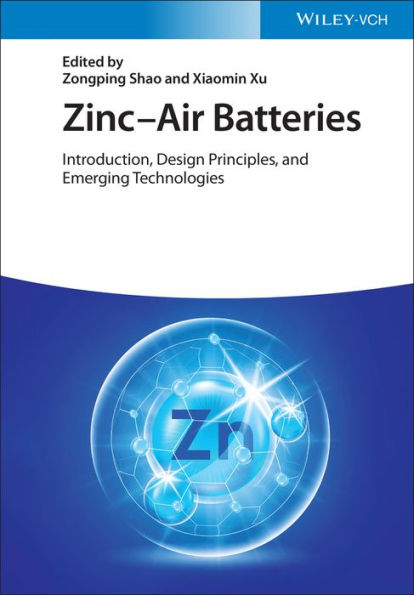Authoritative and comprehensive resource covering foundational knowledge of zinc–air batteries as well as their practical applications
Zinc–Air Batteries provides a comprehensive understanding of the history and development of Zn–air batteries, with a systematic overview of components, design, and device innovation, along with recent advances in the field, especially with regards to the cathode catalyst design made by cutting-edge materials, engineering processes, and technologies.
In particular, design principles regarding the key components of Zn–air batteries, ranging from air cathode, to zinc anode, and to electrolyte, are emphasized. Furthermore, industrial developments of Zn–air batteries are discussed and emerging new designs of Zn–air batteries are also introduced. The authors argue that designing advanced Zn–air battery technologies is important to the realization of efficient energy storage and conversion—and, going further, eventually holds the key to a sustainable energy future and a carbon-neutral goal.
Edited and contributed to by leading professionals and researchers in the field, Zinc–Air Batteries also contains information regarding:
- Design of oxygen reduction catalysts in primary zinc–air batteries, including precious metals, single-atoms, carbons, and transition metal oxides
- Design of bifunctional oxygen catalysts in rechargeable zinc–air batteries, covering specific oxygen redox reactions and catalyst candidates
- Design of three-dimensional air cathode in zinc–air batteries, covering loading of carbon-based and transition metal catalysts, plus design of the three-phase interface
- Design of electrolyte for zinc–air batteries, including liquid electrolytes (e.g., alkaline) and gel polymer electrolytes (e.g., PVA hydrogel)
For students, researchers, and instructors working in battery technologies, materials science, and electrochemistry, and for industry and government representatives for decision making associated with energy and transportation, Zinc–Air Batteries summarizes the research results on Zn–air batteries and thereby helps researchers and developers to implement the technology in practice.
Authoritative and comprehensive resource covering foundational knowledge of zinc–air batteries as well as their practical applications
Zinc–Air Batteries provides a comprehensive understanding of the history and development of Zn–air batteries, with a systematic overview of components, design, and device innovation, along with recent advances in the field, especially with regards to the cathode catalyst design made by cutting-edge materials, engineering processes, and technologies.
In particular, design principles regarding the key components of Zn–air batteries, ranging from air cathode, to zinc anode, and to electrolyte, are emphasized. Furthermore, industrial developments of Zn–air batteries are discussed and emerging new designs of Zn–air batteries are also introduced. The authors argue that designing advanced Zn–air battery technologies is important to the realization of efficient energy storage and conversion—and, going further, eventually holds the key to a sustainable energy future and a carbon-neutral goal.
Edited and contributed to by leading professionals and researchers in the field, Zinc–Air Batteries also contains information regarding:
- Design of oxygen reduction catalysts in primary zinc–air batteries, including precious metals, single-atoms, carbons, and transition metal oxides
- Design of bifunctional oxygen catalysts in rechargeable zinc–air batteries, covering specific oxygen redox reactions and catalyst candidates
- Design of three-dimensional air cathode in zinc–air batteries, covering loading of carbon-based and transition metal catalysts, plus design of the three-phase interface
- Design of electrolyte for zinc–air batteries, including liquid electrolytes (e.g., alkaline) and gel polymer electrolytes (e.g., PVA hydrogel)
For students, researchers, and instructors working in battery technologies, materials science, and electrochemistry, and for industry and government representatives for decision making associated with energy and transportation, Zinc–Air Batteries summarizes the research results on Zn–air batteries and thereby helps researchers and developers to implement the technology in practice.

Zinc-Air Batteries: Introduction, Design Principles, and Emerging Technologies
304
Zinc-Air Batteries: Introduction, Design Principles, and Emerging Technologies
304
